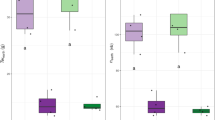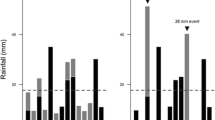Abstract
Water infiltration rates k were measured in mesocosms with soil and “white grubs” of Ancognatha falsa (Arrow) (Coleoptera: Melolonthidae). Three third instars of A. falsa and three adult earthworms Pontoscolex corethrurus were selected, weighted, and introduced into the mesocosms setting three treatments: soil + A. falsa, soil + P. corethrurus, and control (soil without any macroorganism). The experiment had a completely random design with four replicates per treatment (n = 4). The infiltration rates of soil matrix were assessed in each mesocosms with a minidisk tension infiltrometer. Six measurements were made along the experiment. Results showed that larvae of A. falsa promoted a higher water infiltration in the soil, compared to the control. On day 7, k values were similar among treatments, but k values after 28 days and up to 100 days were much higher in the A. falsa treatment (k = 0.00025 cm s−1) if compared to control (k = 0.00011 cm s−1) and P. corethrurus (k = 0.00008 cm s−1) treatments. The k values were significantly higher in the presence of larvae of A. falsa compared to the control and P. corethrurus treatments. The larvae of A. falsa are potential candidates for new assays on soil water infiltration with different tensions to evaluate the role of pores and holes created by the larvae on soils.

Similar content being viewed by others
References
Angulo Jaramillo R, Vandervaere JP, Roulier S, Thony JL, Gaudet JP, Vauclin M (2000) Field measurement of soil hydraulic properties by disc and ring infiltrometers, a review and recent developments. Soil Till Res 55:1–29
Aragón GA, Nochebuena Trujillo CD, Morón MA, López-Olguín JF (2008) Uso de trampas de luz fluorescente para el manejo de la gallina ciega (Coleoptera: Melolonthidae) en maíz (Zea mays L.). Agrociencia 42:217–223
Archer NAL, Quinton JN, Hess TM (2002) Below-ground relationships of soil texture, roots and hydraulic conductivity in two-phase mosaic vegetation in South-east Spain. J Arid Environ 52:535–553
Barois I, Lavelle P, Toutain F, Villemin G (1993) Transformation of the soil structure trough Pontoscolex corethrurus (Oligochaeta) intestinal tract. Geoderma 56:57–66
Barros E, Grimaldi M, Sarrazin M, Chauvel A, Mitja D, Desjardins T, Lavelle P (2004) Soil physical degradation and changes in macrofaunal communities in Central Amazon. Appl Soil Ecol 26:157–168
Bastardie F, Cannavacciuolo M, Capowiez Y, De Dreuzy JR, Bellido A, Cluzeau D (2002) A new simulation for modelling the topology of earthworm burrow systems and their effects on macropore flow in experimental soils. Biol Fert Soil 36:161–169
Blanchart E, Lavelle P, Braudeau E, LeBissonnais Y, Valentin C (1997) Regulation of soil structure by geophagous earthworm activities in humid savannas of Côte d’Ivoire. Soil Biol Biochem 29:431–439
Bouma J (1991) Influence of soil macroporosity on environmental quality. Adv Agron 46:1–37
Brown GG, Oliveira LJ, Norton D, Alberton O, Brandão Jr O, Saridakis GP, Torres E (2003) Quantifying scarab beetle-grub holes and their volume as affected by different tillage and crop management systems. In Proc. 16th ISTRO Conference, Australia: 213–218
Brown J, Scholtz CH, Janeau JL, Grellier S, Podwojewski P (2010) Dung beetles (Coleoptera: Scarabaeidae) can improve soil hydrological properties. Appl Soil Ecol 46(1):9–16
Castro Ramírez AE, Perales Rivera HR, Parra Tabla V (2006) Propuesta metodológica para la evaluación del daño ocasionado por “gallina ciega” (Coleoptera) al maíz (Zea mays L.). In: Castro Ramírez AE, Morón MA, Aragón A (eds) Diversidad, importancia y manejo de escarabajos edafícolas. ECOSUR, Fundación PRODUCE Chiapas, BUAP, Puebla, pp 163–180
Colloff MJ, Pullen KR, Cunningham SA (2010) Restoration of an ecosystem function to revegetation communities: the role of invertebrate macropores in enhancing soil water infiltration. Restor Ecol 18:65–72
De la Rosa Flores IN, Negrete Yankelevich S (2012) Distribución espacial de la fauna edáfica en bosque mesófilo, bosque secundario y pastizal en la reserva La Cortadura, Coatepec, Veracruz. Rev Mex Biodiv 83:201–215
Decagon-Devices (2006) Mini disk infiltrometer: Model S, user’s manual versión 3. Decagon Devices, Pullman
Edwards WM, Shipitalo MJ, Owens LB, Norton LD (1990) Effects of Lumbricus terrestris burrows on hydrology of continuous no-till corn fields. Geoderma 46:73–84
Eldridge DJ (1993) Effects of ants on sandy soils in semi-arid eastern Australia 1. Local distribution of nest entrances and their effect on infiltration of water. Aust J Soil Res 31(4):509–518
Fatehnia M, Tawfiq K, Abichou T (2014) Comparison of the methods of hydraulic conductivity estimation from mini disk infiltrometer. EJGE 19:1047–1063
García JA, Fragoso C (2003) Influence of different food substrates on growth and reproduction of two tropical earthworm species (Pontoscolex corethrurus and Amynthas corticis). Pedobiologia 47:754–763
Gómez Tagle A, Gutiérrez Gnecchi JA, Zepeda Castro H (2010) Dispositivo de automatización para un infiltrómetro de campo con funcionamiento de Mariotte. Terra Latinoamericana 28(3):193–202
Hallaire V, Curmi P, Duboisset A, Lavelle P, Pashanasi B (2000) Soil structure changes induced by the tropical earthworm Pontoscolex corethrurus and organic inputs in a Peruvian ultisol. Eur J Soil Biol 36:35–44
Jones CG, Lawton JH, Shachak M (1997) Positive and negative effects of organisms as physical ecosystem engineers. Ecology 78:1946–1957
Lavelle P, Barois I, Cruz I, Fragoso C, Hernandez A, Pineda A, Rangel P (1987) Adaptive strategies of Pontoscolex corethrurus (Glossoscolecidae, Oligochaeta), a peregrine geophagous earthworm of the humid tropics. Biol Fert Soil 5(3):188–194
Lavelle P, Bignell DE, Lepage M, Wolters V, Roger P, Ineson P, Heal OW, Dhillion S (1997) Soil function in a changing world: the role of invertebrate ecosystem engineers. Eur J Soil Biol 33:159–193
Logsdon SD, Jaynes DB (1993) Methodology for determining hydraulic conductivity with tension infiltrometers. Soil Sci Soc Am J 57:1426–1431
Luque JL, Peinemann N (1995) Conductividad hidráulica en suelos vérticos del Valle inferior del Río Ciibut frente a la aplicación de diferentes enmiendas. Ciencia del Suelo 13:70–75
Meysman FJR, Middelburg JJ, Heip CHR (2006) Bioturbation: a fresh look at Darwin’s last idea. Trends Ecol Evol 21:688–695
Morón MA (2001) Larvas de escarabajos del suelo en México (Coleoptera: Melolonthidae). Acta Zool Mex (n e) 1:111–130
Morón Ríos A (2008) Litter consumption by Xyloryctes lobicollis (Bates) (Coleoptera: Scarabaeidae: Dynastinae) larvae and its contribution to soil nutrients. Coleopts Bull 62:331–332
Morón MA, Ratcliffe BC, Deloya C (1997) Atlas de los escarabajos de México. Coleoptera: lamelicornia. Vol. I. Familia melolonthidae. Rutelinae, dynastinae, cetoniinae, trichiinae, valginae y melolonthinae. Comisión Nacional para el Conocimiento y Uso de la Biodiversidad y Sociedad Mexicana de Entomología, Xalapa
Muñoz Hernández A, Morón MA, Aragón A (2008) Coleoptera Scarabaeoidea de la región de Teziutlán, Puebla, México. Acta Zool Mex (n s) 24:55–78
Neita Moreno JC, Morón MA (2008) Estados inmaduros de Ancognatha ustulata (coleoptera: melolonthidae: dynastinae: cyclocephalini). Rev Mex Biodiv 79:355–361
Nuutinen V, Pitkanen J, Kuusela E, Widbom T, Lohilahti H (1998) Spatial variation of an earthworm community related to soil properties and yield in a grass-clover field. Appl Soil Ecol 8:85–94
Pitkanen J, Nuutinen V (1998) Earthworm contribution to infiltration and surface runoff after 15 years of different soil management. Appl Soil Ecol 9:411–415
Reynolds WD, Elrick DE (1991) Determination of hydraulic conductivity using a tension infiltrometer. Soil Sci Soc Am J 55:633–639
Romero López AA, Morón MA, Aragón A, Villalobos FJ (2010) La “gallina ciega” (Coleoptera: Scarabaeoidea: Melolonthidae) vista como un “ingeniero del suelo”. Southwest Entomol 35:331–343
Romero López AA, Negrete Yankelevich S, De la Rosa I, Geissert D (2012) Presencia de “gallinas ciegas“(Coleoptera: Scarabaeoidea: Melolonthidae) en el bosque mesófilo y su distribución espacial en un pastizal. Southwest Entomol 37(3):419–422
Shipitalo MJ, Le Bayon RC (2004) Quantifying the effects of earthworms on soil aggregation and porosity. In: Edwards CA (ed) Earthworm ecology. CRC Press, Boca Raton, pp 183–200
Tapia Rojas AM, Morón MA, Aragón A, López Olguín JF (2003) Determinación de melolonthidae (Insecta: coleoptera) en algunos suelos forestales del estado de puebla, México. In: Aragón A, Morón MA, Marín-Jarillo A (eds) Estudios sobre coleópteros del suelo en América. Pub. especial BUAP, Puebla, pp 129–135
Topoliantz S, Ponge JF (2003) Burrowing activity of the geophagous earthworm Pontoscolex corethrurus (Oligochaeta: Glossoscolecidae) in the presence of charcoal. Appl Soil Ecol 23:267–271
Villalobos FJ (1994) The contribution of Melolonthid larvae to soil fertility. Proc. 15th World Congress of Soil Science IVd: 129–143
Willoughby GL, Kladivko EJ (2002) Water infiltration rates following reintroduction of Lumbricus terrestris into no-till fields. J Soil Water Conserv 57(2):82–88
Yan Li X, González A, Solé Benet A (2005) Laboratory methods for the estimation of infiltration rate of soil crusts in the Tabernas Desert badlands. Catena 60:255–266
Zapata Sierra A, Manzano Agugliaro F (2008) Influencia de seis especies arbóreas en la infiltración de agua en el suelo. Agrociencia 42:835–845
Zhang R (1997) Infiltration models for the disk infiltrometer. Soil Sci Soc Am J 61:1597–1603
Acknowledgments
The authors thank S. Rocha, N. Portilla, L. Cruz and V. Méndez, A. Santos, and M. de los Santos (INECOL) for their support in soil analysis and experimental logistics and SEP-CONACyT for the financial support and a Postdoc scholarship under the project no. 106788.
Author information
Authors and Affiliations
Corresponding author
Additional information
Edited by Kleber Del Claro – UFU
Rights and permissions
About this article
Cite this article
Romero-López, A.A., Rodríguez-Palacios, E., Alarcón-Gutiérrez, E. et al. Effects of White Grubs on Soil Water Infiltration. Neotrop Entomol 44, 134–139 (2015). https://doi.org/10.1007/s13744-015-0273-x
Received:
Accepted:
Published:
Issue Date:
DOI: https://doi.org/10.1007/s13744-015-0273-x




